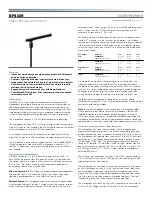
broadcast & production
microphones
BP4029
Stereo Shotgun Microphone
Features
• Innovative stereo shotgun engineered for professional broadcast
and production applications
• Compact, lightweight design is perfect for camera-mount use
• Independent line-cardioid and figure-of-eight condenser elements
• Switch selection of non-matrixed M-S mode and two internally
matrixed left/right stereo modes
• Rugged design and construction for reliable performance
• Switchable 80 Hz high-pass filter minimizes pickup of undesired
low-frequency sounds
Description
The BP4029 is a fixed-charge stereo condenser microphone with
independent line-cardioid and figure-of-eight elements configured in a
Mid-Side arrangement with switch-selectable internal matrixing. The
microphone allows sound recordists the choice of selecting a left-right
stereo output (wide or narrow) via the microphone’s internal matrixing
system or choosing discrete Mid-Side signals for later manipulation.
The microphone requires 11V to 52V phantom power for operation.
The microphone includes a 0.61 m (24") dual output cable terminating in a
5-pin XLRF-type to two standard 3-pin XLRM-type connectors. The output
of the microphone is a 5-pin XLRM-type connector.
A switch permits choice of flat response or low-frequency roll-off (via
integral 80 Hz high-pass filter) to help control undesired ambient noise.
The microphone is enclosed in a rugged housing. The included AT8405a
stand clamp permits mounting on any microphone stand with
5
/
8
"-27
threads. A windscreen, two o-rings and a protective carrying case are
also included.
Operation and Maintenance
The BP4029 requires 11V to 52V phantom power on Pins 2 and 3 of
both XLR3M-type connectors for operation. Wiring must be balanced
throughout, and all mic cables in the system must be wired consistently:
Pin 1-to-Pin 1, etc. If connecting to unbalanced inputs, good-quality
balanced line transformers must be used.
Mid-side Operation:
In M-S mode, the microphone provides independent
Mid and Side signals. This allows the width of the stereo image to be
adjusted in post production or in the field with a matrix mixer.
Matrixed Stereo:
The microphone offers two internally matrixed modes
which provide traditional “left-right” stereo without the need for external
mixers. To accommodate varying acoustic environments, the user may
select between a “wide” pattern (LR-W) with increased ambient pickup,
and a “narrow” pattern (LR-N) which offers more rejection and less
ambience. Output phase is “Pin 2 hot.”
For correct left-right stereo orientation, position the microphone so the
word “UP” is on top, with the switches on the bottom. In all modes,
locating the microphone nearer the sound source enhances the apparent
width of the stereo image, while decreasing room ambience. Moving
away from the sound source will result in a narrower stereo image and
more “room sound.”
M-S Output
Connector
Pin 1
Pin 2
Pin 3
Mid
XLR3M-Gray
Ground
Mid +
Mid –
XLR5M Mic Connector:
Pin 1
Pin 2
Pin 3
Side
XLR3M-Red
Ground
Side +
Side –
XLR5M Mic Connector:
Pin 1
Pin 4
Pin 5
Matrix Output
Connector
Pin 1
Pin 2
Pin 3
Left
XLR3M-Gray
Ground
L +
L –
XLR5M Mic Connector:
Pin 1
Pin 2
Pin 3
Right
XLR3M-Red
Ground
R +
R –
XLR5M Mic Connector:
Pin 1
Pin 4
Pin 5
An integral 80 Hz high-pass filter provides easy switching from a flat
frequency response to a low-end roll-off. The roll-off position reduces
the pickup of low-frequency ambient noise (such as traffic, air-handling
systems, etc.), room reverberation and mechanically coupled vibrations.
To engage the high-pass filter, use the end tip of a paperclip or other
small pointed instrument to slide the switch toward the “bent” line.
Avoid leaving the microphone in the open sun or in areas where
temperatures exceed 110° F (43° C) for extended periods. Extremely high
humidity should also be avoided.
Note:
To use the microphone with a camera-mount microphone holder
whose diameter is too large to secure the microphone, slide the two
supplied o-rings onto the microphone handle, spaced so that one fits
just in front of, and the other fits just behind, the rubber nubs inside the
microphone holder. When the top of the microphone holder is closed and
tightened down, the o-rings should hold the microphone securely in place.
Architect’s and Engineer’s Specifications
The microphone shall be a shotgun design with two independent
fixed-charge condenser elements. It shall have line-cardioid and figure-
of-eight polar patterns and a frequency response of 40 Hz to 20,000 Hz.
The microphone shall operate from an external 11V to 52V DC phantom
power source. It shall be capable of handling sound input levels up to
123 dB (mid), 127 dB (side), 126 dB (left/right stereo) with a dynamic
range of 101 dB (mid), 101 dB (side), 102 dB (left/right stereo). Nominal
open circuit output voltage shall be 31.6 mV (mid), 19.9 mV (side), 15.8
mV (left/right stereo) at 1 V, 1 Pascal. Output shall be low impedance
balanced (200 ohms).
The output of the microphone shall be a 5-pin XLRM-type connector. A
0.61 m (24") cable with a 5-pin XLRF-type to two standard 3-pin XLRM-
type connectors shall be included.
The microphone shall include a switch to permit choice of flat response
or 80 Hz low-frequency roll-off. It shall also include switch selection of
non-matrixed M-S mode and two internally matrixed left-right stereo
modes. The M-S mode shall provide independent Mid and Side signals.
The two internally matrixed modes shall provide traditional “left-right”
stereo with the choice of wide and narrow pickup patterns.
The microphone shall be 236.0 mm (9.29") long and have a diameter of
21.0 mm (0.83"). Weight shall be 103 grams (3.6 oz). The microphone


